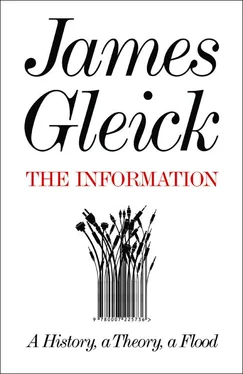A book of numbers: amid all the species of information technology, how peculiar and powerful an object this is. “Lo! the raptured arithmetician!” wrote Élie de Joncourt in 1762. “Easily satisfied, he asks no Brussels lace, nor a coach and six.” Joncourt’s own contribution was a small quarto volume registering the first 19,999 triangular numbers. It was a treasure box of exactitude, perfection, and close reckoning. These numbers were so simple, just the sums of the first n whole numbers: 1, 3 (1+2), 6 (1+2+3), 10 (1+2+3+4), 15, 21, 28, and so on. They had interested number theorists since Pythagoras. They offered little in the way of utility, but Joncourt rhapsodized about his pleasure in compiling them and Babbage quoted him with heartfelt sympathy: “Numbers have many charms, unseen by vulgar eyes, and only discovered to the unwearied and respectful sons of Art. Sweet joy may arise from such contemplations.”
Tables of numbers had been part of the book business even before the beginning of the print era. Working in Baghdad in the ninth century, Abu Abdullah Mohammad Ibn Musa al-Khwarizmi, whose name survives in the word algorithm , devised tables of trigonometric functions that spread west across Europe and east to China, made by hand and copied by hand, for hundreds of years. Printing brought number tables into their own: they were a natural first application for the mass production of data in the raw. For people in need of arithmetic, multiplication tables covered more and more territory: 10 × 1,000, then 10 × 10,000, and later as far as 1,000 × 1,000. There were tables of squares and cubes, roots and reciprocals. An early form of table was the ephemeris or almanac, listing positions of the sun, moon, and planets for sky-gazers. Tradespeople found uses for number books. In 1582 Simon Stevin produced Tafelen van Interest , a compendium of interest tables for bankers and moneylenders. He promoted the new decimal arithmetic “to astrologers, land-measurers, measurers of tapestry and wine casks and stereometricians, in general, mint masters and merchants all.” He might have added sailors. When Christopher Columbus set off for the Indies, he carried as an aid to navigation a book of tables by Regiomontanus printed in Nuremberg two decades after the invention of moveable type in Europe.
Joncourt’s book of triangular numbers was purer than any of these— which is also to say useless. Any arbitrary triangular number can be found (or made) by an algorithm: multiply n by n + 1 and divide by 2. So Joncourt’s whole compendium, as a bundle of information to be stored and transmitted, collapses in a puff to a one-line formula. The formula contains all the information. With it, anyone capable of simple multiplication (not many were) could generate any triangular number on demand. Joncourt knew this. Still he and his publisher, M. Husson, at the Hague, found it worthwhile to set the tables in metal type, three pairs of columns to a page, each pair listing thirty natural numbers alongside their corresponding triangular numbers, from 1(1) to 19,999(199,990,000), every numeral chosen individually by the compositor from his cases of metal type and lined up in a galley frame and wedged into an iron chase to be placed upon the press.
Why? Besides the obsession and the ebullience, the creators of number tables had a sense of their economic worth. Consciously or not, they reckoned the price of these special data by weighing the difficulty of computing them versus looking them up in a book. Precomputation plus data storage plus data transmission usually came out cheaper than ad hoc computation. “Computers” and “calculators” existed: they were people with special skills, and all in all, computing was costly.
Beginning in 1767, England’s Board of Longitude ordered published a yearly Nautical Almanac , with position tables for the sun, moon, stars, planets, and moons of Jupiter. Over the next half century a network of computers did the work—thirty-four men and one woman, Mary Edwards of Ludlow, Shropshire, all working from their homes. Their painstaking labor paid £70 a year. Computing was a cottage industry. Some mathematical sense was required but no particular genius; rules were laid out in steps for each type of calculation. In any case the computers, being human, made errors, so the same work was often farmed out twice for the sake of redundancy. (Unfortunately, being human, computers were sometimes caught saving themselves labor by copying from one other.) To manage the information flow the project employed a Comparer of the Ephemeris and Corrector of the Proofs. Communication between the computers and comparer went by post, men on foot or on horseback, a few days per message.
A seventeenth-century invention had catalyzed the whole enterprise. This invention was itself a species of number, given the name logarithm . It was number as tool. Henry Briggs explained:
Logarithmes are Numbers invented for the more easie working of questions in Arithmetike and Geometrie. The name is derived of Logos , which signifies Reason , and Arithmos , signifying Numbers . By them all troublesome Multiplications and Divisions in Arithmetike are avoided, and performed onely by Addition in stead of Multiplication, and by Subtraction in stead of Division.
In 1614 Briggs was a professor of geometry—the first professor of geometry—at Gresham College, London, later to be the birthplace of the Royal Society. Without logarithms he had already created two books of tables, A Table to find the Height of the Pole, the Magnetic Declination being given and Tables for the Improvement of Navigation , when a book came from Edinburgh promising to “take away all the difficultie that heretofore hath beene in mathematical calculations.”
There is nothing (right well beloved Students in the Mathematickes) that is so troublesome to Mathematicall practice, not that doth more molest and hinder Calculators, then the Multiplications, Divisions, square and cubical Extractions of great numbers, which besides the tedious expence of time, are for the most part subject to many slippery errors.
This new book proposed a method that would do away with most of the expense and the errors. It was like an electric flashlight sent to a lightless world. The author was a wealthy Scotsman, John Napier (or Napper, Nepair, Naper, or Neper), the eighth laird of Merchiston Castle, a theologian and well-known astrologer who also made a hobby of mathematics. Briggs was agog. “Naper, lord of Markinston, hath set my head and hands a work,” he wrote. “I hope to see him this summer, if it please God, for I never saw book, which pleased me better, and made me more wonder.” He made his pilgrimage to Scotland and their first meeting, as he reported later, began with a quarter hour of silence: “spent, each beholding other almost with admiration before one word was spoke.”
Briggs broke the trance: “My Lord, I have undertaken this long journey purposely to see your person, and to know by what engine of wit or ingenuity you came first to think of this most excellent help unto astronomy, viz. the Logarithms; but, my Lord, being by you found out, I wonder nobody else found it out before, when now known it is so easy.” He stayed with the laird for several weeks, studying.
In modern terms a logarithm is an exponent. A student learns that the logarithm of 100, using 10 as the base, is 2, because 100 = 10 2. The logarithm of 1,000,000 is 6, because 6 is the exponent in the expression 1,000,000 = 10 6. To multiply two numbers, a calculator could just look up their logarithms and add those. For example:
100 × 1,000,000 = 10 2× 10 6= 10 (2 + 6)
Looking up and adding are easier than multiplying.
But Napier did not express his idea this way, in terms of exponents. He grasped the thing viscerally: he was thinking in terms of a relationship between differences and ratios. A series of numbers with a fixed difference is an arithmetic progression: 0, 1, 2, 3, 4, 5 . . . When the numbers are separated by a fixed ratio, the progression is geometric: 1, 2, 4, 8, 16, 32 . . . Set these progressions side by side,
Читать дальше











